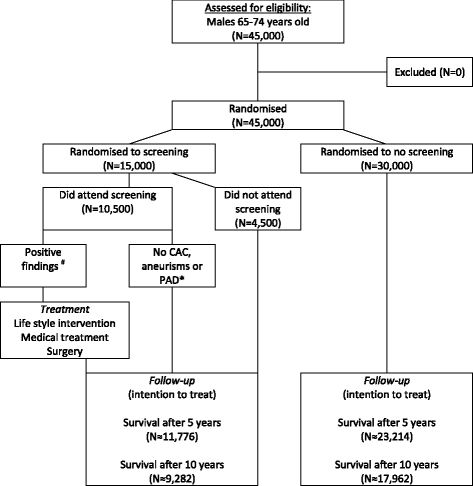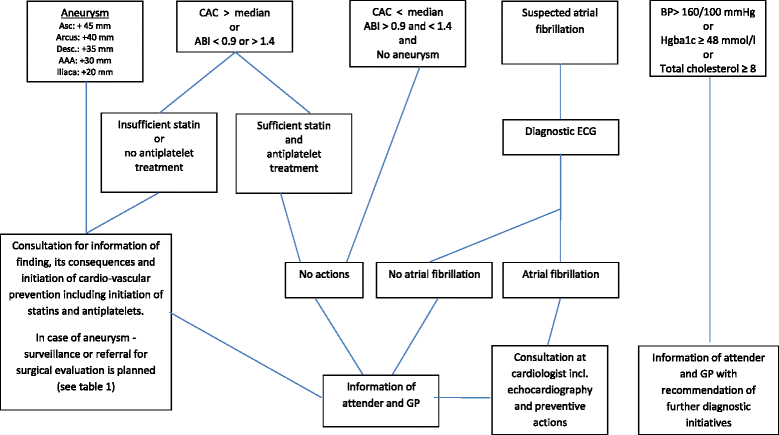The Danish Cardiovascular Screening Trial (DANCAVAS): study protocol for a randomized controlled trial
- PMID: 26637993
- PMCID: PMC4670524
- DOI: 10.1186/s13063-015-1082-6
The Danish Cardiovascular Screening Trial (DANCAVAS): study protocol for a randomized controlled trial
Abstract
Background: The significant increase in the average life expectancy has increased the societal challenge of managing serious age-related diseases, especially cancer and cardiovascular diseases. A routine check by a general practitioner is not sufficient to detect incipient cardiovascular disease.
Design: Population-based randomized clinically controlled screening trial.
Participants: 45,000 Danish men aged 65-74 years living on the Island of Funen, or in the surrounding communities of Vejle and Silkeborg. No exclusion criteria are used.
Interventions: One-third will be invited to cardiovascular seven-faceted screening examinations at one of four locations. The screening will include: (1) low-dose non-contrast CT scan to detect coronary artery calcification and aortic/iliac aneurysms, (2) brachial and ankle blood pressure index to detect peripheral arterial disease and hypertension, (3) a telemetric assessment of the heart rhythm, and (4) a measurement of the cholesterol and plasma glucose levels. Up-to-date cardiovascular preventive treatment is recommended in case of positive findings.
Objective: To investigate whether advanced cardiovascular screening will prevent death and cardiovascular events, and whether the possible health benefits are cost effective.
Outcome: Registry-based follow-up on all cause death (primary outcome), and costs after 3, 5 and 10 years (secondary outcome).
Randomization: Each of the 45,000 individuals is, by EPIDATA, given a random number from 1-100. Those numbered 67+ will be offered screening; the others will act as a control group.
Blinding: Only those randomized to the screening will be invited to the examination;the remaining participants will not. Numbers randomized: A total of 45,000 men will be randomized 1:2. Recruitment: Enrollment started October 2014.
Outcome: A 5% reduction in overall mortality (HR=0.95), with the risk for a type 1 error=5% and the risk for a type II error=80%, is expected. We expect a 2-year enrollment, a 10-year follow-up, and a median survival of 15 years among the controls. The attendance to screening is assumed to be 70%.
Discussion: The primary aim of this so far stand-alone population-based, randomized trial will be to evaluate the health benefits and costeffectiveness of using non-contrast full truncus computer tomography (CT) scans (to measure coronary artery calcification (CAC) and identify aortic/iliac aneurysms) and measurements of the ankle brachial blood pressure index (ABI) as part of a multifocal screening and intervention program for CVD in men aged 65-74. Attendance rate and compliance to initiated preventive actions must be expected to become of major importance.
Trial registration: Current Controlled Trials: ISRCTN12157806 (21 March 2015).
Figures
References
-
- Hjertestatistik 2013. http://www.hjerteforeningen.dk/film_og_boeger/udgivelser/hjertestatistik/.
Publication types
MeSH terms
Substances
Associated data
LinkOut - more resources
Full Text Sources
Other Literature Sources
Medical



